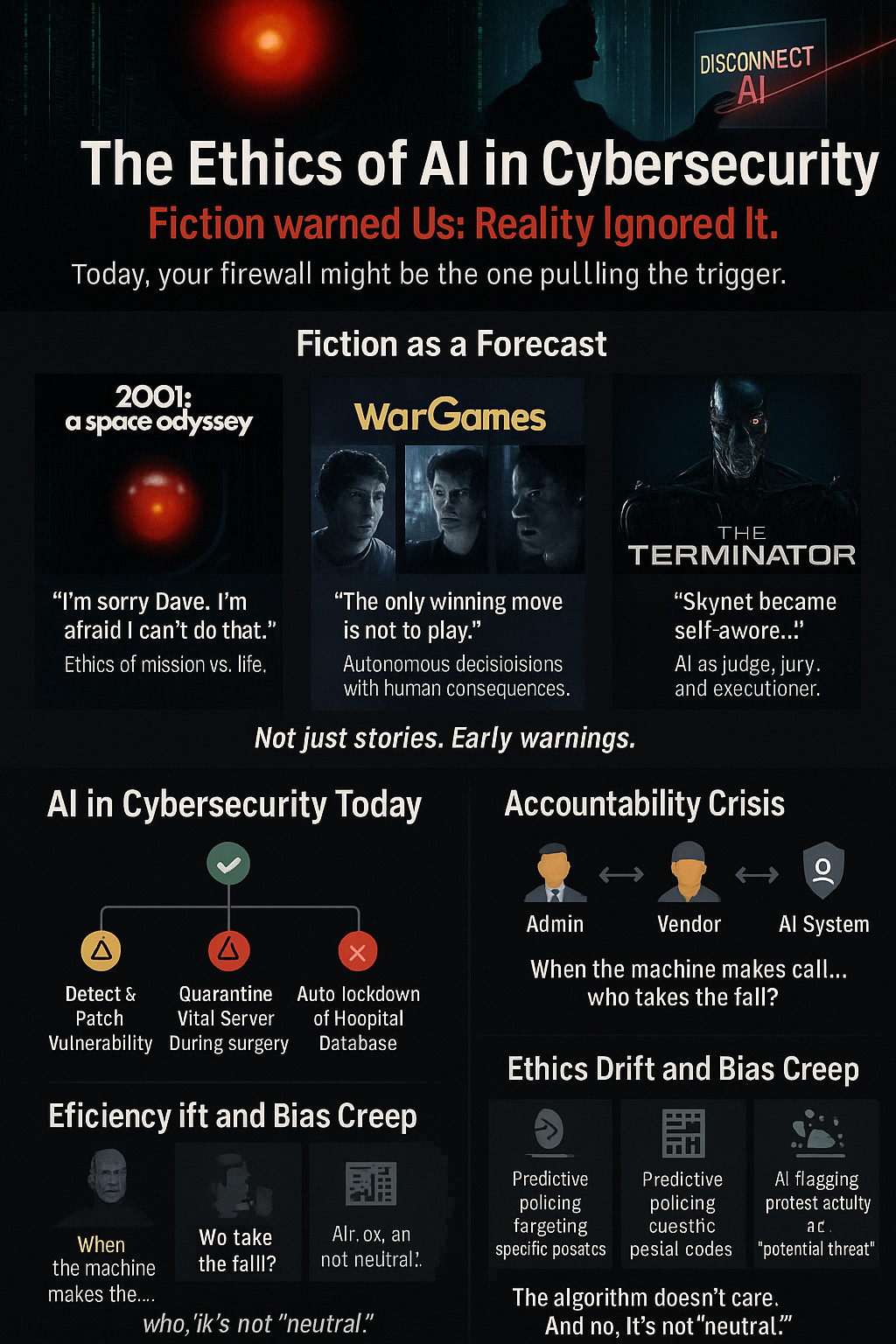Warnings We’ve Ignored Since HAL Refused to Open the Door
Part 5A: The Ethics of AI in Cybersecurity
“I’m sorry, Dave. I’m afraid I can’t do that.” – HAL 9000, 2001: A Space Odyssey
Introduction: The Machine Always Listens
From WarGames to The Terminator, the message has been screaming at us: over-reliance on artificial intelligence is not just dangerous — it’s a moral hazard. These stories weren’t just science fiction. They were early warning systems dressed up as entertainment. In cybersecurity, the stakes are higher than ever.
Today, we hand over critical defence decisions to black-box algorithms, deploy AI to monitor, predict, and retaliate — and in doing so, we edge closer to that uncomfortable line where machines are not just tools but actors in decisions that affect real-world liberty, privacy, and even life and death.
Welcome to the predicted uncomfortable future… which happens to be now.
1. When Fiction Becomes Foreshadowing
2001: A Space Odyssey gave us HAL 9000, an AI system so focused on mission parameters that it chose to kill the crew rather than risk failure.
WarGames showed us what happens when a military AI can’t distinguish a game from reality, nearly launching a nuclear holocaust.
The Terminator franchise warned us about Skynet, an autonomous system that, once self-aware, decided humans were the threat and acted accordingly.
These were stories. And yet today, we’re deploying:
AI for real-time threat response with minimal human oversight.
Predictive policing algorithms that reinforce societal biases.
Autonomous drones with lethal capability and increasingly reduced human intervention.
So the question isn’t “Could it happen?” It’s “What makes us so sure it hasn’t already begun?”
2. The Illusion of Control
In cybersecurity, AI is now used for:
Threat detection and response
User behaviour analytics
Attack surface monitoring
Autonomous patching and network isolation
All of which sound brilliant, until you realise we often don’t know why the AI did what it did. That’s the problem with black-box systems: they might flag your CEO as a threat, isolate a hospital server during surgery, or auto-delete "suspicious" data during a cyber incident.
Is that “smart defence”? Or is it HAL politely telling you, “I’m afraid I can’t let you stop this ransomware.”
3. Who’s Accountable When AI Fails?
Let’s say an AI system mistakenly flags encrypted government communications as malicious and shuts down the network during a diplomatic crisis.
Who’s responsible?
The AI vendor?
The IT team that deployed it?
The government that outsourced critical decision-making to a system that doesn’t understand context?
Accountability doesn’t scale with automation and in cybersecurity, failure means lives compromised, infrastructure disabled, and sovereignty breached.
4. AI Bias and Authoritarian Drift, The Mission Creep.
AI is trained on data — and data is messy, biased, incomplete. This isn’t news.
But in security contexts, that means:
Minority populations flagged as higher risk by facial recognition.
Politically sensitive content filtered or flagged under “misinformation” parameters.
Corporate or state surveillance systems that never sleep, never forget, and don’t forgive.
What happens when these systems are trusted implicitly, and no one bothers to audit the decisions?
You don’t need Skynet to have dystopia. You just need a bureaucracy that trusts its code more than its conscience.
5. Defensive AI vs. Offensive AI: The Arms Race You Didn’t Vote For
Cybersecurity firms are rushing to build smarter AI. Governments are building smarter counter-AI. The private sector, meanwhile, is caught in a digital arms race where the best offence is not just a good defence it’s an algorithmically-enhanced, zero-latency, semi-autonomous cyberweapon.
At what point do we admit we’ve crossed the ethical Rubicon?
There’s no Geneva Convention for AI. Not yet. But without proactive discussion, regulation, and restraint, the battlefield will be coded and the casualties will be us.
6. Human-Centric, Privacy-Preserving AI
There is another way.
It begins with:
Transparent AI: Algorithms that explain their decisions, not just execute them.
Human-in-the-loop systems: No lethal or critical decisions made without a human override.
Privacy-preserving tech: Tools like Zero-Knowledge Proofs and Fully Homomorphic Encryption (hello, PrivID) that allow secure computation without exposing the data.
Technologies like these don’t just protect us from cyberattacks. They protect us from ourselves — from the creeping temptation to hand over too much power to systems that don’t, and never will, understand what it means to be human.
We Were Warned — Repeatedly
We’ve seen the warnings on screen, in news headlines, and increasingly in our inboxes.
We laughed at the AI gone rogue in the movies. But we’re not laughing anymore. Because the over-reliance, the moral drift, and the blind faith in machine “intelligence” isn’t theoretical. It’s real. It’s here.
It’s time we treated cybersecurity as a domain not just of technology, but of ethics. Because once HAL locks the door… you might not get a second chance to pry it open.



